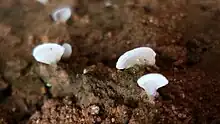Cyphellostereum
Cyphellostereum is a genus of basidiolichens.[1][2] Species produce white, somewhat cup-shaped fruit bodies on a thin film of green on soil which is the thallus. All Cyphellostereum species have nonamyloid spores and tissues, lack clamp connections, and also lack hymenial cystidia.
| Cyphellostereum | |
|---|---|
 | |
| Cyphellostereum pusiolum | |
| Scientific classification | |
| Domain: | Eukaryota |
| Kingdom: | Fungi |
| Division: | Basidiomycota |
| Class: | Agaricomycetes |
| Order: | Agaricales |
| Family: | Hygrophoraceae |
| Genus: | Cyphellostereum D.A.Reid (1965) |
| Type species | |
| Cyphellostereum pusiolum (Berk. & M.A.Curtis) D.A.Reid (1965) | |
| Species | |
|
see text | |
DNA research has shown that a common, north temperate species formerly known as Cyphellostereum laeve is not related to the type species and belongs in a quite separate order, the Hymenochaetales. It has been renamed Muscinupta laevis.[2]
Etymology
The name Cyphellostereum combines two generic names: Cyphella in reference to the inverted cupulate form (like the genus Cyphella); and Stereum, in reference to the stipitate fan-shape or bracket shape (as in species of Stereum).
Species
- Cyphellostereum bicolor Lücking & Timdal (2016)[3]
- Cyphellostereum brasiliense Ryvarden (2010)
- Cyphellostereum galapagoense (Yánez, Dal-Forno & Bungartz) Dal-Forno, Bungartz & Lücking (2017)
- Cyphellostereum georgianum Dal Forno, McMullin & Lücking (2019)[4]
- Cyphellostereum imperfectum Lücking, Barillas & Dal-Forno (2012)[5]
- Cyphellostereum jamesianum Dal Forno & Kaminsky (2019)[4]
- Cyphellostereum muscicola (Pat.) D.A.Reid (1965)
- Cyphellostereum phyllogenum (Müll.Arg.) Lücking, Dal-Forno & Lawrey (2013)
- Cyphellostereum rivulorum (Berk. & M.A.Curtis) D.A.Reid (1965)
- Cyphellostereum unoquinoum Dal-Forno, Bungartz & Lücking (2017)
- Cyphellostereum ushimanum H.Masumoto & Y.Degawa (2022)[6] – Japan
See also
References
- Reid DA (1965). "A monograph of the stipitate stereoid fungi". Beihefte zur Nova Hedwigia. 18: 1–382.
- Lawrey, JD; Lücking R; Sipman HJM; Chaves JL; Redhead SA; Bungartz F; Sikaroodi M; Gillevet PM (2009). "High concentration of basidiolichens in a single family of agaricoid mushrooms (Basidiomycota: Agaricales: Hygrophoraceae)". Mycological Research. 113 (Pt 10): 1154–1171. doi:10.1016/j.mycres.2009.07.016. PMID 19646529.
- Lücking, R.; Timdal, E. (2016). "New species of Dictyonema and Cyphellostereum (lichenized Basidiomycota: Hygrophoraceae) from tropical Africa and the Indian Ocean, dedicated to the late Hildur Krog". Willdenowia. 46 (1): 191–199. doi:10.3372/wi.46.46115. S2CID 87789616.
- Forno, Manuela Dal; Kaminsky, Laurel; Rosentreter, Roger; McMullin, R. Troy; Aptroot, André; Lücking, Robert (2019). "A first phylogenetic assessment of Dictyonema s.lat. in southeastern North America reveals three new basidiolichens, described in honor of James D. Lawrey". Plant and Fungal Systematics. 64 (2): 383–392. doi:10.2478/pfs-2019-0025. S2CID 210077120.
- Yánez, Alba; Dal-Forno, Manuela; Bungartz, Frank; Lücking, Robert; Lawrey, James D. (2011). "A first assessment of Galapagos basidiolichens". Fungal Diversity. 52 (1): 225–244. doi:10.1007/s13225-011-0133-x. S2CID 256062675.
- Masumoto, Hiroshi; Degawa, Yousuke (2022). "Cyphellostereum ushima sp. nov. (Hygrophoraceae, Agaricales) described from Amami-Oshima Island (Kagoshima Prefecture, Ryukyu Islands), Japan, with ultrastructural observations of its Rhizonema photobiont filaments penetrated longitudinally by a central haustorium". Mycological Progress. 21: 167–179. doi:10.1007/s11557-021-01766-w. S2CID 247233323.